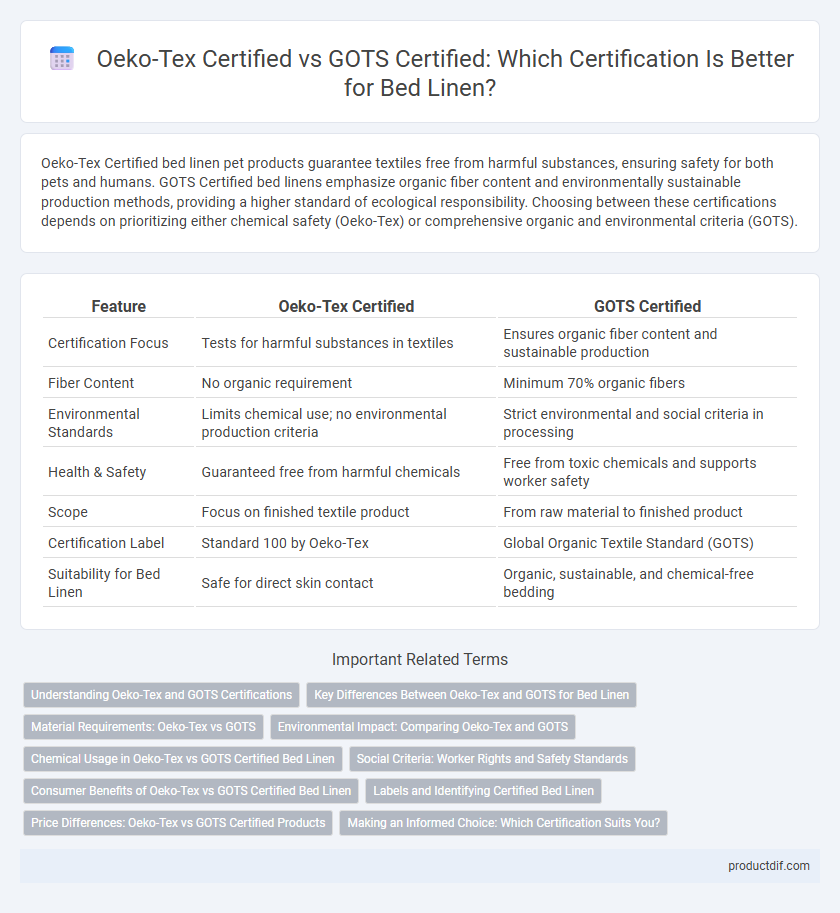Oeko-Tex Certified bed linen pet products guarantee textiles free from harmful substances, ensuring safety for both pets and humans. GOTS Certified bed linens emphasize organic fiber content and environmentally sustainable production methods, providing a higher standard of ecological responsibility. Choosing between these certifications depends on prioritizing either chemical safety (Oeko-Tex) or comprehensive organic and environmental criteria (GOTS).
Table of Comparison
| Feature | Oeko-Tex Certified | GOTS Certified |
|---|---|---|
| Certification Focus | Tests for harmful substances in textiles | Ensures organic fiber content and sustainable production |
| Fiber Content | No organic requirement | Minimum 70% organic fibers |
| Environmental Standards | Limits chemical use; no environmental production criteria | Strict environmental and social criteria in processing |
| Health & Safety | Guaranteed free from harmful chemicals | Free from toxic chemicals and supports worker safety |
| Scope | Focus on finished textile product | From raw material to finished product |
| Certification Label | Standard 100 by Oeko-Tex | Global Organic Textile Standard (GOTS) |
| Suitability for Bed Linen | Safe for direct skin contact | Organic, sustainable, and chemical-free bedding |
Understanding Oeko-Tex and GOTS Certifications
Oeko-Tex certification ensures bed linens are free from harmful substances through rigorous testing for chemical safety, providing consumer confidence in product safety. GOTS certification guarantees organic fiber content and enforces strict environmental and social criteria throughout the entire textile supply chain, emphasizing sustainable production and fair labor practices. Both certifications highlight different aspects of textile quality, with Oeko-Tex focusing on chemical safety and GOTS on organic integrity and ethical standards.
Key Differences Between Oeko-Tex and GOTS for Bed Linen
Oeko-Tex Certified bed linens ensure textiles are free from harmful substances, focusing primarily on chemical safety throughout production, while GOTS Certified bed linens emphasize organic fiber content, environmental sustainability, and social criteria in manufacturing. Oeko-Tex certification tests finished products for toxins, making it ideal for consumers prioritizing non-toxic bedding, whereas GOTS certification covers the entire supply chain, guaranteeing organic farming practices and fair labor conditions. Selecting between Oeko-Tex and GOTS bed linen depends on whether the priority is chemical safety or comprehensive organic and ethical standards.
Material Requirements: Oeko-Tex vs GOTS
Oeko-Tex Certified bed linens ensure materials are free from harmful substances, emphasizing rigorous chemical testing for safety and environmental impact. GOTS Certified fabrics go further by mandating organic fiber sourcing, sustainable farming practices, and strict social criteria alongside chemical restrictions. While Oeko-Tex focuses primarily on material safety, GOTS offers a comprehensive standard covering organic material integrity and eco-friendly production processes.
Environmental Impact: Comparing Oeko-Tex and GOTS
Oeko-Tex Certified bed linens ensure textiles are free from harmful substances, focusing primarily on consumer safety and chemical restrictions, while GOTS Certified products address comprehensive environmental and social criteria, including organic fiber sourcing and sustainable manufacturing processes. GOTS certification demands stringent controls on water usage, wastewater treatment, and prohibits synthetic fertilizers and pesticides, making it a more holistic standard for minimizing environmental impact. Oeko-Tex offers a crucial but narrower scope, mainly targeting human-ecological safety rather than the full lifecycle environmental footprint.
Chemical Usage in Oeko-Tex vs GOTS Certified Bed Linen
Oeko-Tex Certified bed linen undergoes rigorous testing to ensure textiles are free from harmful substances, with a focus on limiting specific chemicals and allergens throughout production. GOTS Certified bed linen enforces stricter regulations by controlling the entire supply chain, mandating organic fiber content and prohibiting toxic chemicals, pesticides, and synthetic fertilizers. Chemical usage in GOTS-certified products is more comprehensively restricted, ensuring higher environmental and health safety standards compared to Oeko-Tex certifications.
Social Criteria: Worker Rights and Safety Standards
Oeko-Tex Certified bed linens ensure compliance with strict laboratory-tested safety standards, focusing primarily on harmful substances, while also addressing basic worker safety and environmental regulations. GOTS Certified bed linens exceed these requirements by enforcing comprehensive social criteria, including fair wages, safe working conditions, and workers' rights aligned with International Labour Organization (ILO) standards. Choosing GOTS certification guarantees a higher commitment to ethical labor practices and improved social responsibility in the textile supply chain.
Consumer Benefits of Oeko-Tex vs GOTS Certified Bed Linen
Oeko-Tex Certified bed linen guarantees absence of harmful chemicals, ensuring safety and hypoallergenic comfort for sensitive skin, making it ideal for everyday use. GOTS Certified bed linen emphasizes organic fiber use and environmentally sustainable production processes, providing consumers with eco-friendly and socially responsible options. Choosing Oeko-Tex gives consumers confidence in chemical safety, while GOTS focuses more on organic integrity and comprehensive ecological standards.
Labels and Identifying Certified Bed Linen
Oeko-Tex Certified bed linens feature labels ensuring textiles are free from harmful substances, verified through rigorous testing standards like Standard 100 by Oeko-Tex. GOTS Certified linens display the Global Organic Textile Standard label, confirming organic fiber origins and compliance with environmental and social criteria throughout the entire production process. Identifying certified bed linen involves checking for these official marks, with Oeko-Tex focusing on chemical safety and GOTS emphasizing organic content and sustainable manufacturing practices.
Price Differences: Oeko-Tex vs GOTS Certified Products
Oeko-Tex certified bed linen typically costs less than GOTS certified products due to differences in certification requirements and production processes. While Oeko-Tex focuses on ensuring textiles are free from harmful substances, GOTS certification demands stricter organic farming practices and comprehensive environmental and social criteria, increasing production costs. Consumers seeking eco-friendly options often find GOTS certified bed linen priced higher, reflecting its rigorous standards and sustainable sourcing.
Making an Informed Choice: Which Certification Suits You?
Oeko-Tex Certified bed linen guarantees products free from harmful chemicals, ensuring safety and skin-friendliness, whereas GOTS Certified sheets emphasize organic fiber sourcing and comprehensive environmental and social responsibility throughout production. Choosing Oeko-Tex suits consumers prioritizing non-toxic materials and allergy-sensitive bedding, while GOTS is ideal for those committed to certified organic agriculture and fair trade practices. Understanding these certifications enables informed decisions based on personal values, health needs, and sustainability goals.
Oeko-Tex Certified vs GOTS Certified Infographic

 productdif.com
productdif.com